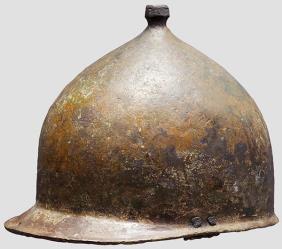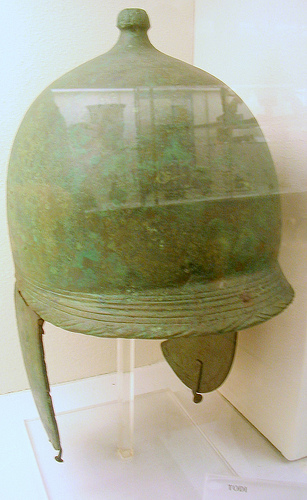It looks like you're using an Ad Blocker.
Please white-list or disable AboveTopSecret.com in your ad-blocking tool.
Thank you.
Some features of ATS will be disabled while you continue to use an ad-blocker.
23
share:
Iron Age Bronze Helmet Found In England
www.huffingtonpost. com
(visit the link for the full news article)
A rare find in England has riveted the British archeological community.
Artifacts, including a bronze helmet dated to the 1st Century B.C.E., were found by a man with a metal detector on farmland near Canterbury in southeastern England, the BBC reports.
"Even for Britain as a whole, I knew such a find would be incredibly rare," Andrew Richardson, the Finds Manager for the Canterbury Archaeological Trust, recounted on the organization's website. "But the finder seemed very confident and I knew he was an experienced detectorist."
Related News Links:
www.bbc.co.uk
Hello ATS.
Being a bit of an amateur historian myself, I was delighted to read this story late this Friday afternoon.
Helm found*

Roman helm*

Bronze age helm*

The man who found the helm has chosen to remain anonymous, which is a bit bizarre...
source
source
Anyway, this find is one of only a hand full of such helmets found on British soil.
I thought some on ATS might enjoy this story.
SS
www.huffingtonpost. com
(visit the link for the full news article)
Being a bit of an amateur historian myself, I was delighted to read this story late this Friday afternoon.
Helm found*

Roman helm*

Bronze age helm*

The man who found the helm has chosen to remain anonymous, which is a bit bizarre...
The Bronze Age is a period characterized by the use of copper and its alloy bronze as the chief hard materials in the manufacture of some implements and weapons. Chronologically, it stands between the Stone Age and Iron Age. The term Stone Age implies the inability to smelt any ore, the term Bronze Age implies the inability to smelt iron ore and the term Iron Age implies the ability to manufacture artifacts in any of the three types of hard material. Their arrangement in the archaeological chronology reflects the difficulty of manufacture in the history of technology.
source
The Iron Age is the archaeological period generally occurring after the Bronze Age, marked by the prevalent use of iron. The early period of the age is characterized by the widespread use of iron or steel. The adoption of such material coincided with other changes in society, including differing agricultural practices, religious beliefs and artistic styles. The Iron Age as an archaeological term indicates the condition as to civilization and culture of a people using iron as the material for their cutting tools and weapons.[1] The Iron Age is the third principal period of the three-age system created by Christian Jürgensen Thomsen for classifying ancient societies and prehistoric stages of progress.[2]
source
Anyway, this find is one of only a hand full of such helmets found on British soil.
I thought some on ATS might enjoy this story.
SS
www.huffingtonpost. com
(visit the link for the full news article)
edit on 123131p://pm3111 by Spike Spiegle because: added pic
edit on
123131p://pm3158 by Spike Spiegle because: added link
edit on 013131p://pm3133 by Spike Spiegle because: more pics
Looks like the guy who wore it got an axe through the skull. Interesting find! Thanks for sharing
reply to post by jvm222
Aye, you saw that too heh
On the other hand, the thing is over 2000 years old, ancient metal things tend to get kind of rusty.
But, I like to think the wearer went down in some epic battle, axe to the brainbox
SS
Aye, you saw that too heh
On the other hand, the thing is over 2000 years old, ancient metal things tend to get kind of rusty.
But, I like to think the wearer went down in some epic battle, axe to the brainbox
SS
edit on 013131p://pm3104 by Spike Spiegle because: ancient*
Kinda looks like a roman legionaire's helm, except those were iron.
reply to post by lonewolf19792000
source

SS
A galea was a Roman soldier's helmet. Some gladiators, myrmillones, also wore a bronze galea with a face mask and a decoration, often a fish on its crest. The exact form or design of the helmet varied significantly over time, between differing unit types, and also between individual examples - pre-industrial production was by hand – so it is not certain to what degree there was any standardization even under the Roman Empire. Originally, Roman helmets were influenced by the neighboring Etruscans, people who utilised the "Nasua" type helmets. The Greeks in the south also influenced Roman design in the early history of Rome. For instance, the ancestor of the Chalcidian helmet, the Attic helmet, was widely used by officers until the end of the empire. Lastly, the Gauls were the peoples who most impacted the design of the Roman helmet hence the popular "Imperial Gallic" type helmets. In addition to this, it is commonly thought that the Gauls also introduced chainmail to the Romans.
source

SS
The first thing I thought of when I saw this:

was of the German Stahlhelm:
[img]http://warrelics.eu/forum/military_photos/imperial-germany-austro-hungary/4538d1233040739t-m16-stahlhelm-battle-somme-m16-helmet.-left-side..jpg[ /img]

was of the German Stahlhelm:
[img]http://warrelics.eu/forum/military_photos/imperial-germany-austro-hungary/4538d1233040739t-m16-stahlhelm-battle-somme-m16-helmet.-left-side..jpg[ /img]
reply to post by Merriman Weir
Not a bad thought considering the " look " of the helm, when considering it's age however...
Unless there were German soldiers wearing stahlhelms in ancient Britannia, the answer to your query would be: No.
SS
Not a bad thought considering the " look " of the helm, when considering it's age however...
Unless there were German soldiers wearing stahlhelms in ancient Britannia, the answer to your query would be: No.
SS
Originally posted by Spike Spiegle
reply to post by Merriman Weir
Not a bad thought considering the " look " of the helm, when considering it's age however...
Unless there were German soldiers wearing stahlhelms in ancient Britannia, the answer to your query would be: No.
SS
Erm, there was no query. I didn't ask anything.
I was simply pointing out that the first thing it reminded me of was a Stahlhelm. I didn't suggest it was a Stahlhelm; that would be ridiculous.
reply to post by Merriman Weir
My first guess... looks very much like a Etrusco-Roman bronze helmet minus the acorn knob on top and cheek plates.


My first guess... looks very much like a Etrusco-Roman bronze helmet minus the acorn knob on top and cheek plates.


edit on 7-12-2012 by flyingfish because: (no reason given)
reply to post by flyingfish
Nice catch, could very well be it, the " acorn " is missing on the helm that was recovered and the Etrusco-Roman bronze helmet fits the timeline nicely...
source

SS
Nice catch, could very well be it, the " acorn " is missing on the helm that was recovered and the Etrusco-Roman bronze helmet fits the timeline nicely...
An Etrusco-Roman bronze helmet of Montefortino/Rieti type late 2nd to middle 1st century B.C. Hemispherical bowl wrought in one piece out of sheet bronze, on the top a finial acorn knob with punched decor, around the rim a border of incised parallel mouldings widening at the back to an avantail decorated with many small struck patterns and a rivet hole for a thong, on each side two holes for affixing the cheek flaps.
source

SS
reply to post by Spike Spiegle
The article did not seem to go into much detail about the type of helmet. Looking at your last post I would bet it's a Etrusco-Roman bronze helmet.
I enjoy metal detecting myself that would be a find of a lifetime despite the damage.
Nice picture love ancient armor history.
The article did not seem to go into much detail about the type of helmet. Looking at your last post I would bet it's a Etrusco-Roman bronze helmet.
I enjoy metal detecting myself that would be a find of a lifetime despite the damage.
Nice picture love ancient armor history.
edit on 8-12-2012 by flyingfish because: (no reason given)
reply to post by flyingfish
Thank you for first bringing it up, I just did a few quick Google search's afterwards...
Regarding ancient history, armors, general military history be it BC or AD, I find it all to be fascinatingglad to see another History buff among the crowd ( History forum please:roll
I think we may have got it, time will tell...
Thanks.
SS
Thank you for first bringing it up, I just did a few quick Google search's afterwards...
Regarding ancient history, armors, general military history be it BC or AD, I find it all to be fascinatingglad to see another History buff among the crowd ( History forum please:roll
I think we may have got it, time will tell...
Thanks.
SS
Awesome, i'm interested in the theories on that helmet's history. So many.
edit on 12-8-12 by Mugen because: (no reason given)
reply to post by Merriman Weir
Sadly if it was aired on history channel not only would it not be ridiculous, but it would be considered possible.

On the other hand, it's funny how little odd finds like this would be the highlight of some "mainstream scientists" career, but if there are no aliens or time travelling nazi's it just doesn't quite muster a response from the general public...
Erm, there was no query. I didn't ask anything.
I was simply pointing out that the first thing it reminded me of was a Stahlhelm. I didn't suggest it was a Stahlhelm; that would be ridiculous.
Sadly if it was aired on history channel not only would it not be ridiculous, but it would be considered possible.

On the other hand, it's funny how little odd finds like this would be the highlight of some "mainstream scientists" career, but if there are no aliens or time travelling nazi's it just doesn't quite muster a response from the general public...
reply to post by boncho
Slightly off topic but that guy, meme, and your whole point is so true.
*hats off to you sir
SS
Slightly off topic but that guy, meme, and your whole point is so true.
*hats off to you sir
SS
new topics
-
Former DOJ charged with defrauding Rep. Matt Gaetz’s family over sex-crimes investigation
Propaganda Mill: 1 hours ago
top topics
-
The mysterious death of Aileen Conway
General Chit Chat: 16 hours ago, 6 flags -
Swedish Minister for Gender Equality is Seeking Treatment for Phobia of Bananas
Other Current Events: 12 hours ago, 6 flags -
Former DOJ charged with defrauding Rep. Matt Gaetz’s family over sex-crimes investigation
Propaganda Mill: 1 hours ago, 5 flags -
USA-BIDEN and CHINA-Xi Agree Not To Let Artificial Intelligence Decide Nuclear Weapons Use.
World War Three: 13 hours ago, 3 flags -
Satanic ‘Little Season’ of Deception.. Awaken to the Handiwork of the Creator.
ATS Skunk Works: 13 hours ago, 3 flags
active topics
-
Former DOJ charged with defrauding Rep. Matt Gaetz’s family over sex-crimes investigation
Propaganda Mill • 4 • : fringeofthefringe -
I’m Looking for Information on the Light We See at Death.
The Gray Area • 65 • : whereislogic -
President-elect TRUMP Picks MATT GAETZ for his ATTORNEY GENERAL - High Level PANIC Ensues.
2024 Elections • 94 • : RickinVa -
The art of being offended
Social Issues and Civil Unrest • 53 • : andy06shake -
Swedish Minister for Gender Equality is Seeking Treatment for Phobia of Bananas
Other Current Events • 8 • : bluemooone44 -
How can you defend yourself when the police will not tell you what you did?
Posse Comitatus • 96 • : andy06shake -
Satanic ‘Little Season’ of Deception.. Awaken to the Handiwork of the Creator.
ATS Skunk Works • 6 • : YouSir -
The mysterious death of Aileen Conway
General Chit Chat • 11 • : Shoshanna -
Russia Ukraine Update Thread - part 3
World War Three • 6815 • : Freeborn -
Bucks County commissioners vote to count illegal ballots in Pennsylvania recount
2024 Elections • 22 • : Enduro
23
